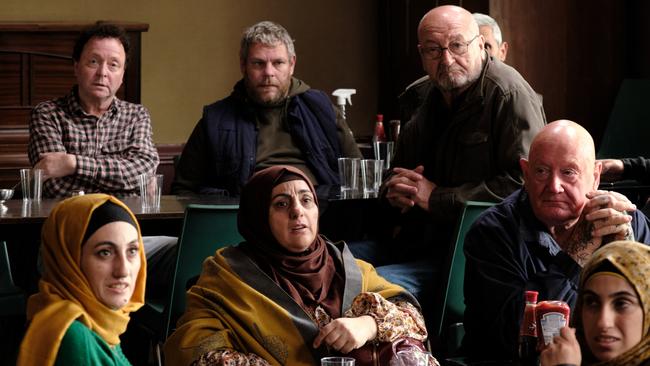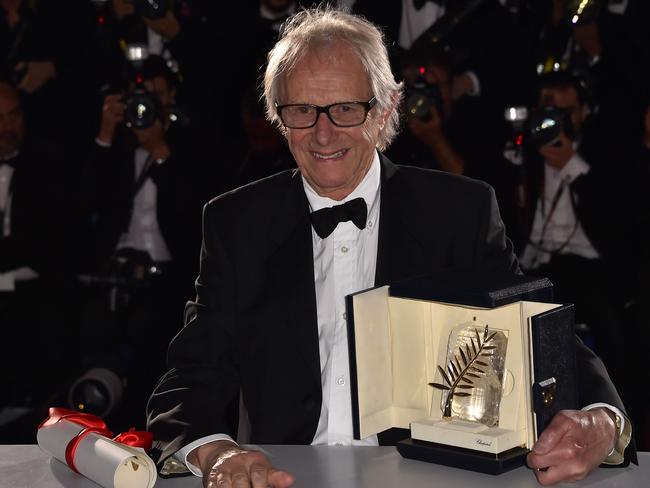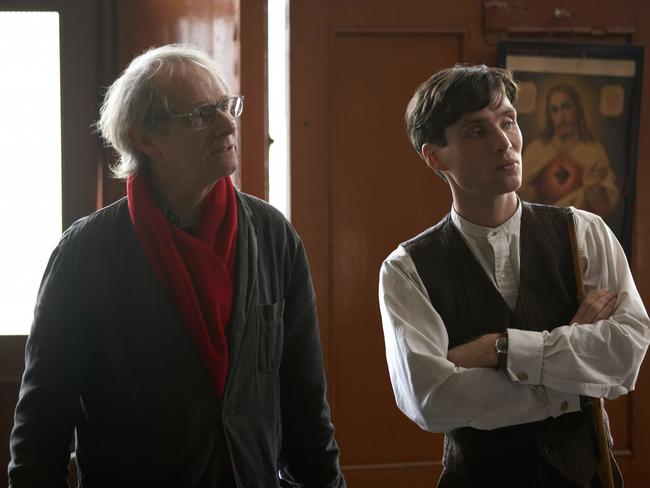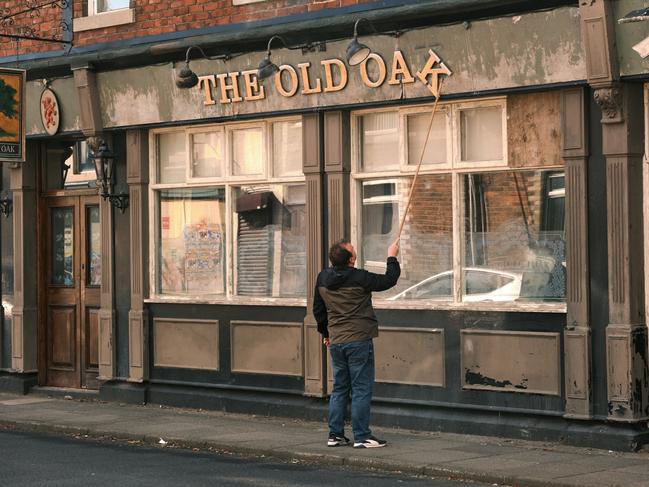Ken Loach releases The Old Oak and retires from feature directing
The story of a poor mining community in northeast England and the arrival of refugees from Syria is the last major film from renowned director Ken Loach.

Ken Loach has an uncanny ability to make his stories of the working class monumental. The British director’s latest, The Old Oak, is the third film in his northeast England trilogy and it will probably be his last dramatic feature. At 87, his faculties are fading: his short-term memory and his eyesight are weak.
“It’s my eyes really,” Loach says. “I mean, it’s bloody age. It’s what happens. Apart from forgetting everything, forgetting my specs, I’m fine, I’m grand. But it’s just not realistic to keep going.”
He’s getting too old, he says, for the rigours of filmmaking.
“It’s the emotional commitment for 12 hours a day, day after day,” he says. “It’s the focusing, the concentration and keeping up the energy because there’s got to be creative energy there. And that comes from the director. If you’re not on top of it every second and talking to everybody all the time, it doesn’t work.”
With The Old Oak, which premiered at the Cannes film festival, Loach is going out with a bang. The Old Oak of the title is a pub in County Durham, in England’s industrial northeast. The social hub of a once-thriving mining community, it and the town have since fallen on hard times. The film follows what happens when families from war-torn Syria are resettled in the town.
“The film tells us what happened when the Syrians first arrived and the connections they’ve made since they’ve been there,” Loach says.
“It’s a struggle because there’s still a feeling of hostility, and the right wing encourages it, you know? Still, there are good connections. Just in the making of the film, the people in the village – it’s actually three villages put together – have made connections with the local Syrians and they now they meet regularly.”
So the film facilitated that?
“It did.”
The idea for the film began when Paul Laverty, a Scottish screenwriter and Loach’s regular collaborator since 1996’s Carla’s Song, was following reports of the 2016 arrival of Syrian refugees in Britain. The Syrians were largely placed in regional areas and the pair decided to make a film about it. The project took a while to come to fruition because of the pandemic and it was a huge undertaking. Casting the Syrian families took six months alone.
“We usually work with people who have not done a lot of acting and they don’t have a professional technique,” Loach says.
“Working with Syrians – who are lovely, absolutely brilliant people – was not easy. There were things I had to ask all the time, like, ‘How would you do this? What do you feel comfortable wearing? What would you do? What is the truth for you?’
“You don’t want to do something they don’t believe in and while you do that for everyone, it’s particularly true of the Syrians as it’s a culture you’re not familiar with and it could change the scene. So you’ve got to slightly rejig it moment by moment.”

The Old Oak features Dave Turner, a local to the area who came to acting in Loach’s 2016 film I, Daniel Blake. He plays TJ, the local publican who is sympathetic to the newly arrived Syrians.
His customers are not so impressed, however, especially when he forms a friendship with a young English-speaking Syrian woman, Yara (Ebla Mari in her first screen role). TJ and Yara decide the Syrian and English communities can be brought together if they share a meal in the back room of the pub.
After I, Daniel Blake, a British box-office hit set around the food bank crisis, and Sorry We Missed You, which focused on the British gig economy, Loach and Laverty wanted their final movie together to be hopeful in tone.
“Deep down we didn’t want to end up with two tragedies and we tried to find some value in life,” Laverty says. “Where do people find nourishment and how do we look after each other? We present two traumatised communities, but they still have the creativity to come together and look after each other and build friendships and build hope. We wanted to examine the notion of hope, which is the fuel of change. How do we look after each other in a world that is just so bonkers?”
He had noticed the closure of public meeting places including church halls, libraries and swimming pools. “I saw that pubs were closing down and falling apart and I thought, ‘What happens if The Old Oak becomes contested territory?’.”

Loach, an avid humanitarian and advocate of left-wing politics, says he and Laverty wanted to depict the economic disadvantage experienced by both the villagers and the Syrians. He points out that mining towns in Britain were effectively shut down in the industrial disputes of the 1980s.
“The coalminers had the strongest union and when Margaret Thatcher achieved her great victory in the ’80s she defeated every union until only the miners were left, and that was the biggest strike,” Loach says.
“The miners were not only strong industrially, they were strong politically. So it was a conscious decision to destroy those communities and no worker has ever gone back. There’s no investment... A lot of the young people have left and the people who come in bring problems, problems of addiction, problems that lead to crime. What was a very functioning community is now destroyed.”
Loach says the film shows what happens when traumatised people from Syria – “people who have been tortured and have had relatives killed” – are brought into a town that is suffering its own problems.
The Wind That Shakes the Barley won Loach his first Palme d’Or in 2006. Across his near 60-year career he has had 18 films screen at Cannes, including 15 in the competition, something no other director has come close to achieving in the festival’s history.

His first film at Cannes was Kes (1969), the story of a boy whose adoption of a young falcon brings respite from his troubled life. The British Film Institute ranked it seventh on its list of the best British films of the 20th century.
Loach also won three Cannes jury prizes for Hidden Agenda, Raining Stones and The Angels’ Share, and Peter Mullan won best actor for his role in Loach’s 1998 film My Name is Joe.
Oppenheimer star Cillian Murphy likewise achieved his career breakthrough in The Wind that Shakes the Barley, Loach’s biggest box-office success. Murphy hails from Cork, where the film is set, and played a young idealist who becomes an IRA volunteer during the Irish War of Independence.
“It was quite a magical experience because we didn’t know the script and we were shooting in real time, so there was very little intellectualisation and we had to react instinctively,” Murphy once told this writer. “It was a very honest and scary way of working.”
Loach has stayed in touch with Murphy and he went to see Oppenheimer, for which the actor will surely be Oscar-nominated. “Cillian is a good friend, a lovely man and he is immensely talented. He’s a fine actor,” Loach says.
Famed French footballer Eric Cantona has also remained a good friend since Loach made 2009’s Looking for Eric in which Cantona appeared. Cantona had approached the director with the idea of making a film about his relationship with his British fans and Loach, a football fanatic, couldn’t resist.

In a 2009 interview Cantona compared working with Loach to his collaboration with Alex Ferguson, the Manchester United coach with whom he enjoyed immense success. “They are two humble people who got me to give every bit of myself and who bring out the best in everyone,” Cantona said.
Does Loach still support his home football team in Bath? “Indeed, yes,” he enthuses. “You can’t change your team, can you?”
Does he go to the matches? “Yes, yes of course. I’ve got a season ticket, so I go when I’m at home. I go and suffer. I mean, there’s always more pain than pleasure, isn’t there, when following a football team?”
He doesn’t have a special box. “I just want to be part of the gang really on the terraces and abuse the referee,” he says.
Doesn’t that go against his mild-mannered persona? “Well, I abuse him in a moderate way.”
Loach had considered retirement after his 2014 Irish period drama Jimmy’s Hall, but felt compelled to return to comment on the current state of Britain in what has become his final trilogy.

Laverty says it’s time for his good friend to step away from big demanding projects and that maybe they could collaborate in future on a documentary.
“Ken showed remarkable courage to dive in and do it again with The Old Oak because he doesn’t do things by half, you know,” he says.
“But I wouldn’t want him to go through that again. He’s my friend before he is a filmmaker with whom I collaborate. I see the glass as half full – it’s not coming to an end but you’re just realising your luck.”
After an astonishing six-decade career, Loach increasingly feels the pull of home.
“I was away from home on and off for the best part of a year for this film and, you know, my wife gets a bit fed up with that,” he says, chuckling. “You’ve got to be sensible about it, really.”
The Old Oak is released in cinemas on Thursday.

To join the conversation, please log in. Don't have an account? Register
Join the conversation, you are commenting as Logout